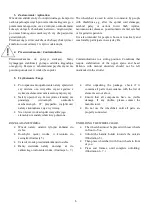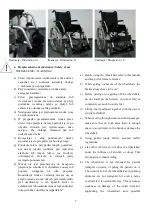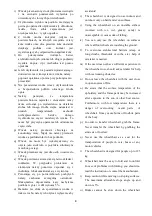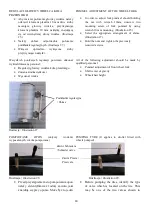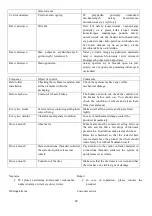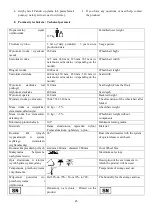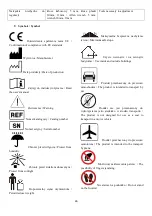
12
Ilustracja / Illustration 16. Ilustracja / Illustration 17.
Ilustracja / Illustration 18. Ilustracja / Illustration 19.
PROWADZENIE WÓZKA PRZEZ OPIEKUNA
•
Zawsze przed rozpocz
ę
ciem jazdy nale
ż
y
upewni
ć
si
ę
ż
e
ż
adna cz
ęść
ciała pacjenta lub
jego ubranie nie jest nara
ż
ona na zaczepienie o
ruchome cz
ęś
ci wózka.
•
O ile pacjent nie mo
ż
e samodzielnie utrzyma
ć
pozycji
siedz
ą
cej
nale
ż
y
(dodatkowo)
wyposa
ż
y
ć
wózek w pasy stabilizuj
ą
ce (pasy w
które standardowo wyposa
ż
ony jest wózek,
zabezpieczaj
ą
przed zsuni
ę
ciem si
ę
pacjenta z
siedziska).
•
Wózek nale
ż
y prowadzi
ć
obur
ą
cz.
PORUSZANIE
SI
Ę
PO
POWIERZCHNIACH
POCHYŁYCH
•
Poruszaj
ą
c
si
ę
po
powierzchniach
pochyłych
nale
ż
y
zachowa
ć
szczególn
ą
ostro
ż
no
ść
i
ograniczy
ć
pr
ę
dko
ść
.
•
Nie nale
ż
y porusza
ć
si
ę
po
zbyt
du
ż
ych
pochyło
ś
ciach.
Maksymalne
dopuszczalne k
ą
ty nachylenia podło
ż
a w gór
ę
i
w dół wynosi 5%.
•
Nale
ż
y rozwa
ż
y
ć
mo
ż
liwo
ść
skorzystania z
pomocy opiekuna, je
ż
eli osoba na wózku nie
PUSHING THE WHEELCHAIR BY CARETAKER
•
Before use, make sure that no part of the
patient's body or his / hers clothing is not
exposed to hook with the moving parts of the
wheelchair.
•
If patient can not sit on one's own, wheelchair
should be equipped with stabilizing belts (belts,
which are in standard equipment to protect the
patient from sliding off the seat).
•
Wheelchair should be pushed with both hands.
MOVING ON SLOPES
•
While moving on slopes, use
caution and reduce your speed.
•
Do not move on too high
slopes. The maximum allowable slope
angle up and down is 5%.
•
Consider the possibility of
assistance from the caretaker. If the person on
the wheelchair did not have enough force to
control the wheelchair, the brakes must be on.
•
To prevent tipping over while moving along the
sloping surface, You should be slightly lean
forward to move your centre of gravity forward.
Blokada
podłokietnika /
Armrest block





